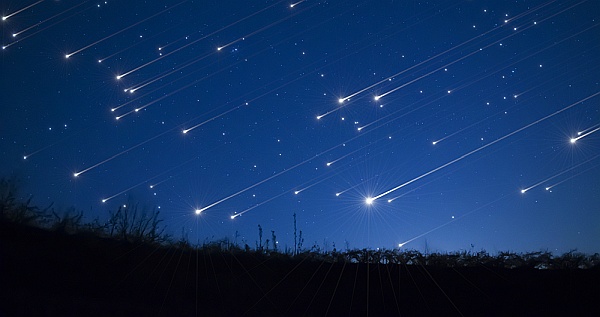Leonid Meteor Shower 2022
- Details
- Written by CrystalWind.ca

The Leonid meteor shower will be active from November 3 to December 2, producing its peak rate of meteors around November 17-18.
Although only 10-15 meteors are created an hour, half of them leave a long-lasting trail across the sky. Under a dark sky, with no moon, you might see 10 to 15 Leonid meteors per hour.
The Leonid meteor storm on November 16, 1833, is assessed to have delivered up to 200,000 falling stars 60 minutes!
November’s wonderful Leonid meteor shower happens every year around November 17 or 18, as our world crosses the orbital path of Comet 55P/Tempel-Tuttle. Like many comets, Tempel-Tuttle litters its orbit with bits of debris. It’s when this cometary debris enters Earth’s atmosphere and vaporizes that we see the Leonid meteor shower.
In 2022, the peak of the shower is expected to be from midnight to dawn on Friday, November 18. The shower will peak close to the new moon, and so moonlight will present minimal interference. In a dark sky, absent of moonlight, you can see up to 10 to 15 meteors per hour at its peak.
When to see them
When should you watch for Leonid meteors in 2022? Knowing what time to watch is easy. As with most meteor showers, the best time to watch the Leonids is usually between the hours of midnight and dawn. The expected peak morning is Friday, November 18. That’s the morning (not the evening) of November 18. :)

Where to see the Leonids
The Leonid meteor shower gets its name from the constellation Leo, where its meteors appear to originate. But you can look in just about any direction to enjoy the show, said NASA meteor expert Bill Cooke. If you directly face Leo, you may miss the meteors with longer tails.
Although the meteor shower might be a bit easier to see from the Northern Hemisphere, skywatchers in the Southern Hemisphere should be able to see the show as well. "They're not quite as good, but almost as good," said Cooke. "The Leonids are an OK shower from the Southern Hemisphere."

What causes the Leonids?
The Leonid meteor shower happens every year in November, when Earth's orbit crosses the orbit of Comet Tempel-Tuttle. The comet makes its way around the sun every 33.3 years, leaving a trail of dust rubble in its wake.
When Earth's orbit crosses this trail of debris, pieces of the comet fall toward the planet's surface. Drag, or air resistance, in Earth's atmosphere cause the comet's crumbs to heat up and ignite into burning balls of fire called meteors. [How Comets Cause Meteor Showers]
These comet crumbs are usually the size of a grain of sand or a pea, so they tend to burn up entirely before striking Earth's surface. Meteors that survive the whole journey to the ground are called meteorites. But the Leonid meteor shower likely won't deliver any meteorites.
What do you need to see them?
Meteors will be visible to the naked eye, so you won't need any special equipment to see them.
"Go outside, find a dark sky, lie flat on your back and look straight up," Cooke said, "and be prepared to spend a couple of hours outside."
Given that the meteors are fairly sparse and take place during a cold time of year, it is best to bundle up, relax.
© 2022 crystalwind.ca. All rights reserved. We track all IP addresses with sniffer technology. Using a Proxy/VPN will not hide your IP address.
Liked this article? Dive deeper into personal growth and wellness! Check out CrystalWind.ca for spiritual wisdom or explore AromaWorx.ca for natural well-being tips. Spread the positivity—share this with friends on their happiness journey!
Let’s Chat! Drop Your Thoughts Below! ![]()
Latest Articles
Dive into the Mystical World of the Crystal Wind Oracle Deck!
Get All the Enchanting Details Now!
NEW Expanded Boxed Edition!
Now with 58 Cards for Richer Wisdom!

Imagine a world of inspiration and healing, free for all—made possible by YOU!
Donate Now—Ignite the Magic at CrystalWind.ca!

Epilepsy - Finding A Cure
Your donation can make a difference!
Help us find a cure – donate now!
Unlock Your Light: Join Lightworkers Worldwide on CrystalWind.ca!
Quake Watch
Articles: The Founders
Articles: Cosmic Neighbours
Articles: Galactic History
Follow Us!
Who is Online Now
We have 33336 guests and no members online
Featured This Month
Frogs Return Moon
Beaver – Chrysocolla - Blue Camas – Blue April 20 – May 20 The Frogs Retur... Read more
The Crystal Wind Oracle Card Deck
The Crystal Wind Oracle™ The Crystal Wind Oracle Myth & Magic Card D... Read more
Cartomancy - Fortune Telling Using Playing C…
Cartomancy is the act of divining using cards. Divining means to find out by... Read more
The Time of No Time: Beltane!
Around the medicine wheel of life we go, from season to season (solstice to ... Read more
Taurus Mythology
The Taurus Myth The story of Taurus is most vividly tied to the tale of Zeu... Read more
Sun in Taurus
Sun in Taurus April 21 through May 21 An Overview of Sun Sign Characteristi... Read more
Bright Beltane Blessings!
The wheel turns to Beltane, also known as Mayday, marking the beginning of S... Read more
The Seven Chakras and their Meanings
If you could imagine chakras as circles of energy, flowing all the way throu... Read more













































